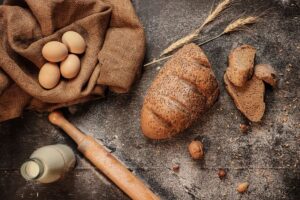Scripture: Ruth 1
Learning Objectives:
- Students will recognize indicators of chemical changes and identify examples.
- Students will recognize indicators of physical changes and identify examples.
- Students will review the story of Boaz’s generosity of grain and food to Ruth.

Guiding Question: What kinds of physical and chemical changes take place when baking bread?
Materials: ingredients for baking bread, oven
Procedure: Bake bread according to the recipe instructions. At each step identify whether the change is chemical or physical. Create a two column chart to list them in.
Teach the basics of chemical and physical changes:
1. Physical change: may change the size, liquid/solid, shape, doesn’t change the properties of the object. Typically it can change back. Examples: mixing, folding, cutting
2. Chemical change: lets off heat, lets of gas/bubbles, lets off light, changes in smell. Changes the properties of the object. It cannot change back. Examples: cooking, burning, freezing, melting
Physical- beating the egg, adding ingredients, stirring, kneading the dough,
Chemical changes- baking in an oven, yeast forming bubbles of gases in dough
Additional Questions:
- What other chemical changes occur in our everyday lives?
- What other physical changes occur in our everyday lives?
Supplemental Activities:
- Students can keep a journal of physical and chemical changes that they see in the course of one day. This can be a list, paragraph or illustrated pictures. Then they can share their findings with each other.
- Find ways of changing food to make a physical or chemical reaction and try them out. For example physical changes might be bending noodles, freezing water into ice cubes, melting a Popsicle, beating an egg, chopping onions. Chemical changes might be: frying/boiling an egg, popping popcorn.
Written by: Savannah Negas
